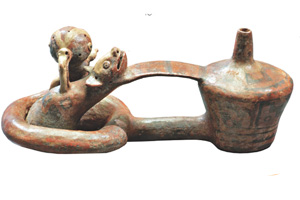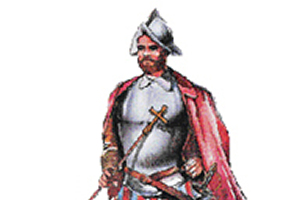The first artistic expressions of the central Andean peoples showed the rich religious and ritual world of these cultures, in a wide variety of images or icons depicted in stone, jewels, ceramics, metal or in textiles. Later these techniques were streamlined and new mystical elements were added, although aspects of daily routine, politics and administration were also introduced into their artistic works.
The chavin style
The Chavín culture developed a unique style in its art, which developed mainly around the ceremonial centre of Huantar. The main motifs were felines, birds of prey and serpents, whose attributes influenced the shapes and arrangements of their artistic works, although these animals were not part of a determined cult themselves. Despite this, in Andean mythology these three beings conserved their role as sentinels of worldly things for centuries.
The Chavín style is present in its stone works, in its great temples, steles and obelisks, and in its ceramics which takes on a stony appearance by not using colour. These works feature symmetry as well as curved lines, and objects such as claws, the so-called «crazy eye» and interlinked fangs.
Four stages can be distinguished in Chavín art: offerings, floral, dragonian and Qotopukio. Aside from the Huacas of the Sun and the Moon, the Moche culture is characterised by depicting daily life in its artistic works. Their ceramics and fabrics thus reflected their customs and traditions. Their bas-reliefs showed realistic drawings with male, animal and plant themes and their busts are considered the best in the Americas. The techniques which they used for these works included pyrographic gourds (decorated by burning), tattooing, mural and body painting, and artwork with feathers.
They were great metalsmiths, transforming metals such as gold, silver and copper into earrings, bracelets, tweezers and different types of utensils. The tumi or ceremonial knife stood out, which was only carried by authorities.
Andean monuments
The Nazca culture is famous for having left its colossal geoglyphs (drawings engraved into the earth). These can only be seen in their entirety from the air or from high surrounding hills. Much has been speculated about their meaning. It has been said that they are landing strips for alien ships, highways, and astronomical calendars. However, more recent research suggests that they were really ritual landscapes to help obtain water. These same studies have determined that they were sketched with only ropes and stakes.
In ceramics, the Nazcas stood out for their polychrome vessels, in which up to seven colours can be seen. The classic shape is the stirrup handle bottle. The stonework left by the Tiwanaku nation is considered unsurpassable. The rocks of the walls of their buildings fit together perfectly and have embedded and carved figures, such as the bald heads of the Kalasasaya temple or the Sun Gate. The imposing statues carved in stone columns which show standing characters in inalterable poses are also notable.
In pottery their kero cups stood out. They have a narrow base and a wide mouth, and were used for ritual toasts. They were decorated in black, white and orange colours over a red base.
To conclude, Tiwanaku aesthetics was of an imperial character, thought of as one way to keep this culture’s power alive.
Despite the fact that they successfully worked ceramics, the Wari culture stood out mainly because of its textile production. This reflected upon its multicoloured weaving, in the fabrics interwoven with gold and silver and the heavy cloths
A wide variety of interests
One culture which explored varied artistic expressions was the Chimú culture. They were experts in wood carving, feather decoration, the manufacture of steres and in works of shells or semi-precious stones.
Nonetheless, as craftspeople from Sicán Lambayeque took part, they perfected metalworking techniques, making cups, masks and other objects of excellent quality and great beauty, which were used in the ceremonies in which the nobles participated.
They also excelled in textile work, especially in tapestries, whose manufacturing procedures spread throughout all of the northern and central coast of Peru.
Other pre-Columbian cultures of the central Andes which stood out in art were the Chancay, Paracas and Vicús cultures. The first nation made oval pitchers with narrow throats and loose necks, with images of human faces, as well as animal-shaped vessels. Similarly, they made different garments, bags and funeral masks with llama wool, cotton and feathers. They also worked with wood and silver, making small figures and different decorations.
The Paracas excelled in polychrome textiles and bottles with bridge-handles, and the Vicu culture in ceramics and loom working, although they also crafted many decorative items in metal for personal adornment, such as necklace beads, nose rings, crowns, masks and headdresses with sequins and feathers which made noise as one moved about wearing them.








